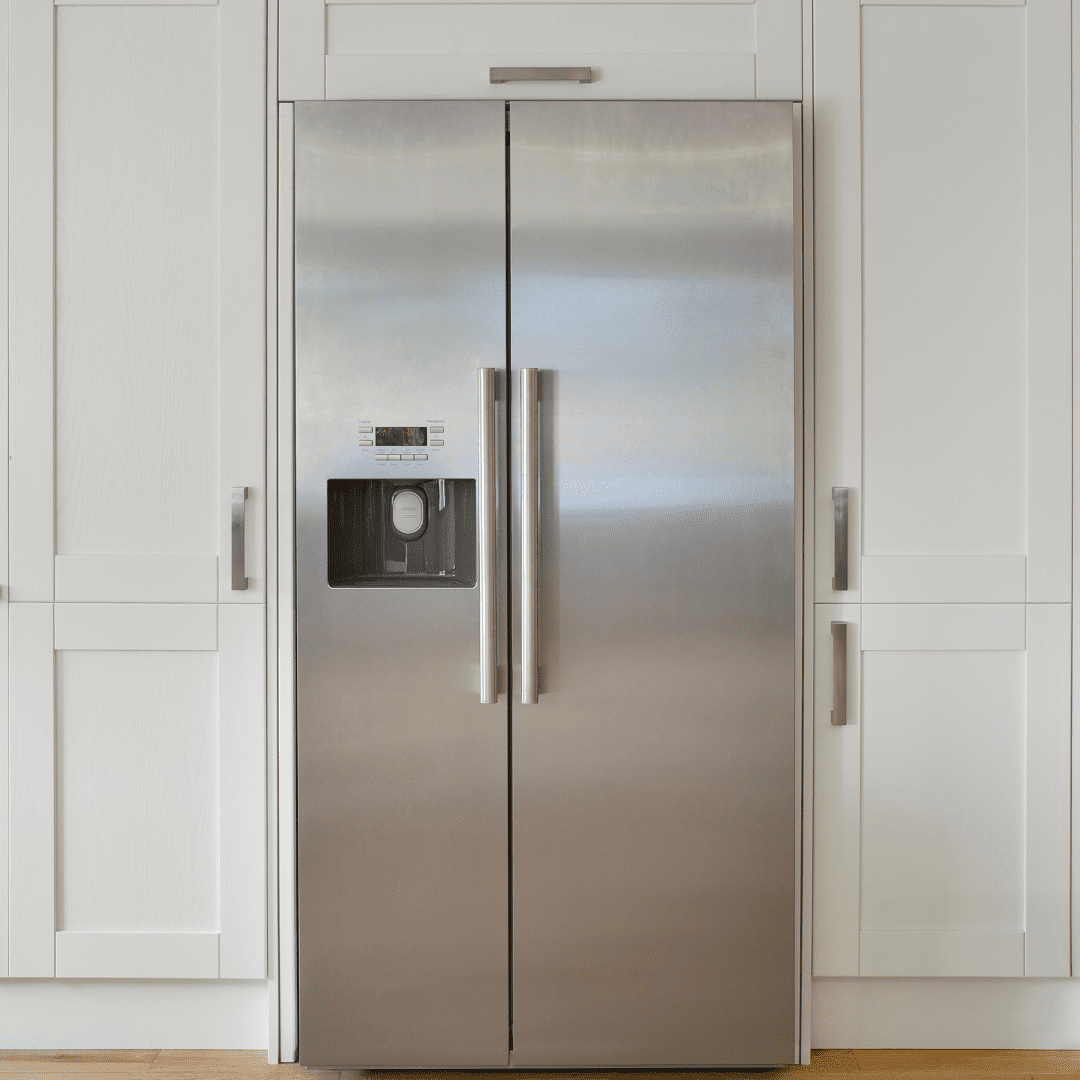Wondering how many watts your fridge uses and how to make it more energy-efficient? This guide breaks down typical fridge wattage, energy-saving tips, and ways to reduce electricity costs without sacrificing food storage. Perfect for off-grid homes, tiny houses, or anyone looking to save power.
Fridges are lifesavers—but they’re also one of the biggest power drains in a home. If you’re off-grid, trying to lower your electricity bills, or just curious about energy use, knowing how many watts your fridge consumes is essential.
In this post, I’m walking you through typical fridge wattage, what affects energy use, and practical tips to make your fridge more efficient. Whether you’re running solar panels, a generator, or just want to cut costs, understanding your fridge’s energy needs is key to keeping your food safe without wasting power.
This is a pinnable post. Tap or hover over any image in this post to pin to your Pinterest Boards.

Introduction to Refrigerator Energy Consumption
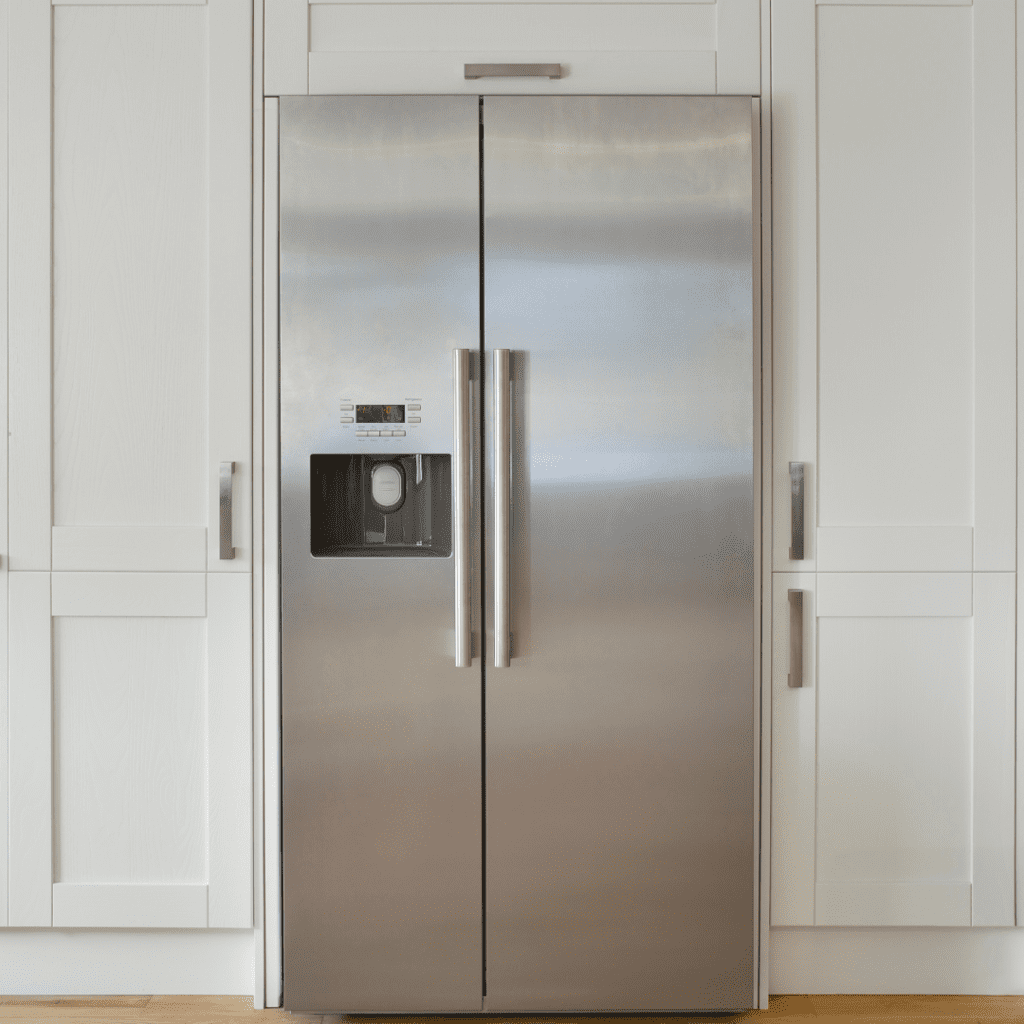
Have you ever wondered just how much power your trusty refrigerator is guzzling up behind closed doors? Understanding the energy consumption of your fridge is not only enlightening, but also a key step toward becoming an energy-savvy homeowner.
The number of watts a fridge uses can vary depending on several factors such as the size, age, and efficiency of the appliance. On average, a standard refrigerator typically consumes between 100 to 800 watts. However, newer energy-efficient models may use closer to 50 to 100 watts, while larger or older models may use more.
To find the exact wattage of your fridge, you can check the appliance’s label or manual, which often includes this information. Additionally, using an energy monitor or consulting with a professional can provide more accurate measurements tailored to your specific refrigerator.
Importance of Understanding Fridge Energy Usage
Knowing how many watts your fridge uses can help you make informed decisions about energy efficiency, savings on utility bills, and reducing your carbon footprint. It’s like peeking behind the curtain to see the wizardry of electricity consumption in your kitchen appliance kingdom!
Let’s learn more about why understanding your fridge’s energy usage is an absolute game-changer. Just know that your fridge isn’t just a box chilling your groceries; it’s a powerhouse impacting your wallet and the environment. By learning more about its energy consumption, we can unlock a world of opportunity to save both cash and the planet.
I will help you uncover the factors influencing how much juice your fridge slurps up and arm you with practical tips to keep it running efficiently.
Understanding Refrigerator Wattage and Energy Efficiency
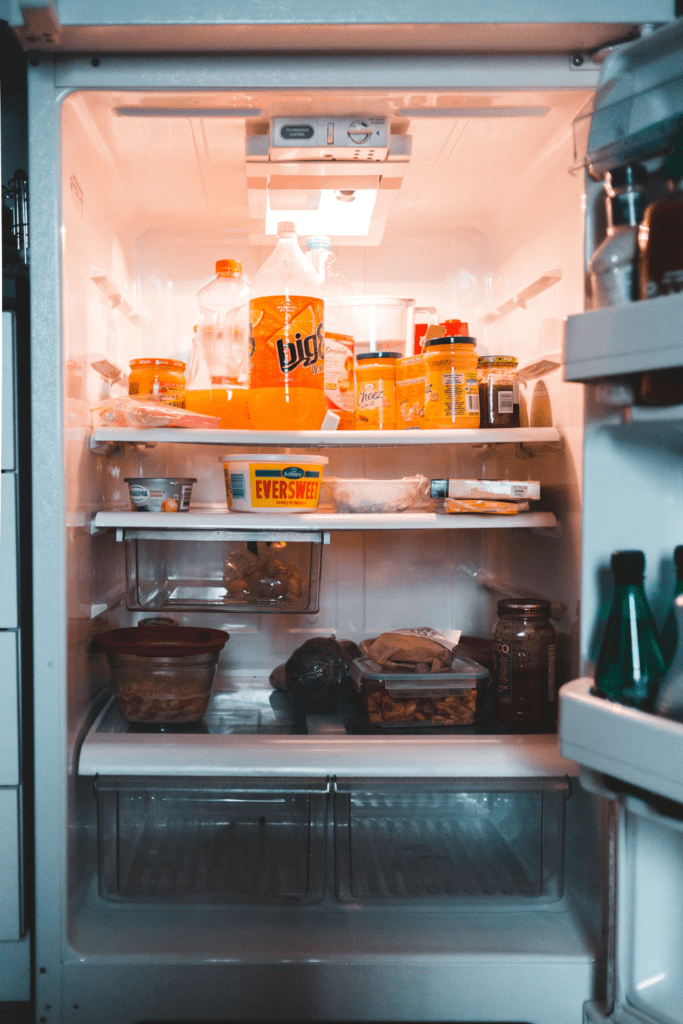
Do you ever wonder just how much power your trusty fridge is consuming day in and day out? Well, buckle up because we’re about to find out! Understanding the wattage and energy efficiency of your refrigerator isn’t just about numbers; it’s about taking control of your energy usage and making smart, eco-friendly choices.
What is Wattage and How Does it Relate to Refrigerators?
Wattage is simply a measure of the amount of power a device consumes. In the case of refrigerators, knowing their wattage can clue you in on how much energy they devour, helping you choose more efficient models and save some money!
Wattage, simply put, is the measure of power consumption – it’s what keeps the lights on and the motors humming. But how does this relate to our fridges? Well, think of wattage as the heartbeat of your refrigerator, dictating just how much energy it needs to keep your food fresh and frosty.
Understanding the wattage of your fridge is like peeking under the hood of your car – it gives you insight into its performance and efficiency.
Energy Efficiency Ratings and Labels Explained
Ever squinted at those mysterious energy efficiency labels on fridges and wondered what they meant? Well, I can decipher these hieroglyphics for you, so you can navigate the sea of options and pick the most energy-savvy fridge for your kitchen.
Energy Efficiency Ratings and Labels
- ENERGY STAR: This is one of the most recognized labels for energy efficiency. Products with the ENERGY STAR label meet or exceed energy efficiency guidelines set by the U.S. Environmental Protection Agency (EPA). Energy Star refrigerators typically use 20% less energy than required by federal standards.
- EnergyGuide Label: This label provides an estimate of the refrigerator’s energy consumption and operating costs compared to similar models. It helps consumers compare the energy efficiency of different appliances.
- Energy Efficiency Ratio (EER): This ratio indicates the energy efficiency of the refrigerator, typically measured in British thermal units (BTUs) of cooling provided per watt-hour of electricity consumed. A higher EER signifies greater energy efficiency.
- Kilowatt-Hours per Year (kWh/yr): This measurement indicates the estimated annual energy consumption of the refrigerator. Lower kWh/yr values signify greater energy efficiency.
- Tier Rating: Some labels categorize appliances into tiers based on their energy efficiency. For example, Tier 1 might represent the most energy-efficient models, while Tier 2 and Tier 3 represent progressively less efficient ones.
- EU Energy Label: In the European Union, refrigerators carry energy labels ranging from A+++ (most efficient) to D (least efficient). These labels also include information on annual energy consumption, capacity, and noise level.
- National Efficiency Standards Labels: Different countries may have their own energy efficiency labeling systems or standards. These labels typically indicate compliance with national regulations regarding energy efficiency.
Understanding these labels can help you choose refrigerators that not only meet your needs, but also minimize energy consumption and environmental impact.
Now, let’s learn how our fridges influence energy consumption in our homes!
Factors Influencing a Fridge’s Energy Consumption
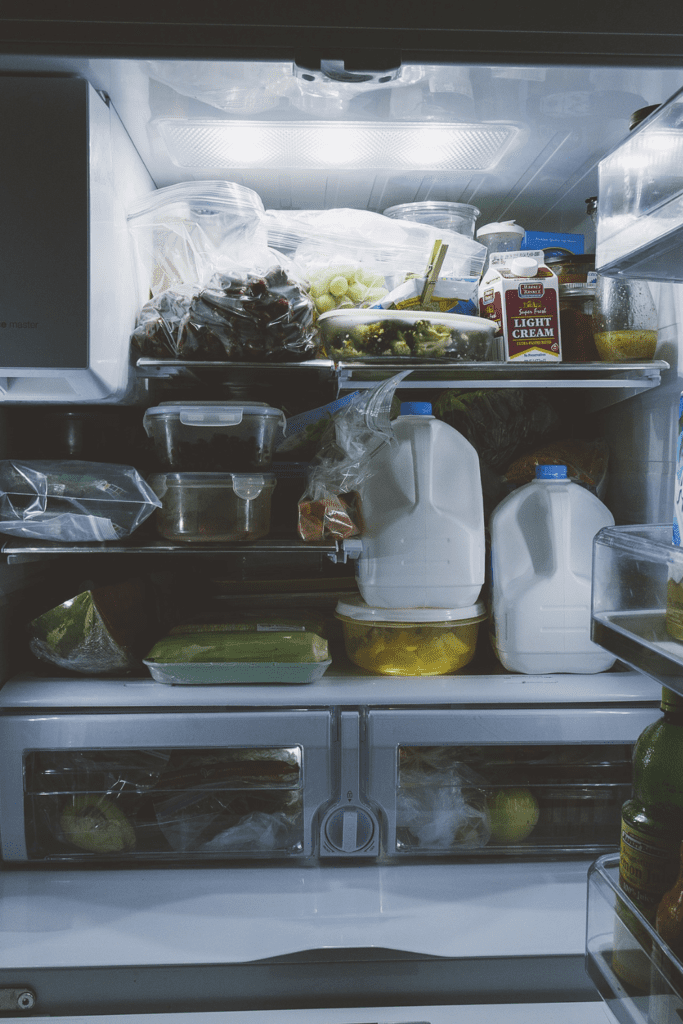
Let’s unravel the enigmatic forces that influence your fridge’s energy consumption. From age to size, these factors play a crucial role in determining how much juice your fridge slurps up, so it is important to learn more about refrigeration efficiency.
Learning more about the factors that sway our trusty fridge’s energy consumption can help us save money. Our fridges are like puzzle boxes, with various elements influencing how much energy they gulp down. From the size and age of our appliances to the temperature settings we choose, every little detail plays a role in their energy appetite.
Understanding these factors is like having a secret weapon in our energy-saving arsenal. We can explore how to optimize our fridge’s performance and keep those energy bills in check.
Age and Condition of the Refrigerator
Just remember some refrigerators become energy-guzzling monsters. However, we can learn more about how the vintage and health of your refrigerator impact its energy consumption, helping you decide if it’s time to bid adieu to your old faithful.
As our refrigerators grow older, they can become less efficient, gobbling up more energy than necessary to keep our goodies cold. By keeping our fridges in tip-top shape through regular maintenance and upgrades when needed, we can ensure they’re running at their most efficient. Think of it as giving your fridge a little TLC to keep it humming along happily.
With fridge maintenance, we can ensure our appliances stay sprightly and our energy bills stay low!
Size and Capacity of the Refrigerator
Size matters, especially when it comes to fridges. The bigger the fridge, the more energy it may chomp through to keep it cool. We can learn more about how the size and capacity of your fridge influence its energy appetite, so you can size up your cooling needs without breaking the bank.
When it comes to size and capacity, bigger isn’t always better. Sure, a spacious fridge may seem like a dream, but it can also mean more energy consumption. By right-sizing our fridges to match our needs and lifestyles, we can strike the perfect balance between space and efficiency.
Temperature Settings and Usage Frequency
By the way, are you a habitual fridge door lingerer, or do you keep things ice-cold with minimal fuss? Your temperature settings and how often you peek into the fridge can impact its energy consumption. This post should shed light on how these habits sway the energy equation and help you chill out responsibly.
Therefore, I want to talk a bit about temperature settings and usage frequency. Our fridges carefully balance temperatures to keep our food fresh and delicious. But did you know that the way we set our fridge temperature and how often we open its doors can impact its energy consumption?
It’s true! By dialing in the perfect temperature and being mindful of how often we peek inside, we can help our fridges run more efficiently and keep those energy bills in check.
Calculating Energy Usage and Costs of a Refrigerator

Ready to crunch some numbers and save some money on energy costs? I’ll equip you with the tools to calculate your fridge’s energy usage and unravel the mysteries of electricity costs lurking in your utility bills.
Think of it like solving a puzzle – with each piece representing the energy our fridge consumes and the dollars it adds to our bills. By understanding how to calculate energy usage and costs, we can gain valuable insights into our household expenses and make informed decisions about our energy consumption.
Calculating the Energy Usage and Costs of a Refrigerator
- Determine the Wattage: Find the wattage of your refrigerator, usually listed on a label inside the appliance or in the owner’s manual.
- Estimate Daily Usage: Track how many hours per day your refrigerator runs. This can vary based on factors like temperature settings, door openings, and the age of the appliance.
- Convert Watts to Kilowatts: Divide the wattage by 1000 to convert it to kilowatts (kW), as most utility bills are measured in kilowatt-hours (kWh).
- Calculate Daily Energy Consumption: Multiply the refrigerator’s kilowatt usage by the number of hours it runs per day to determine its daily energy consumption.
- Monthly Energy Consumption: Multiply the daily energy consumption by 30 (average number of days in a month) to find the monthly energy usage in kilowatt-hours (kWh).
- Cost per kWh: Check your electricity bill or contact your utility provider to find the cost per kilowatt-hour (kWh) of electricity.
- Calculate Monthly Cost: Multiply the monthly energy usage (in kWh) by the cost per kWh to find the monthly cost of operating your refrigerator.
- Annual Cost: Multiply the monthly cost by 12 to determine the annual cost of running your refrigerator.
By following these steps, you can gain a better understanding of how much energy your refrigerator consumes and how it contributes to your overall electricity costs.
Methods for Determining Fridge Energy Consumption
From simple math to high-tech energy monitors, there are various methods to unveil your fridge’s energy secrets. I’ll guide you through these techniques, so you can become a savvy sleuth in deciphering your appliance’s energy appetite.
- One method is to use an energy monitor, a nifty gadget that tracks the electricity flowing to your fridge in real time, giving you a precise picture of its energy appetite.
- Another approach is to consult your fridge’s manual or look for an energy label inside the appliance, which often provides valuable information about its wattage and annual energy consumption.
- You can also use online calculators specifically designed for estimating fridge energy usage based on factors like size, age, and usage patterns.
Methods for Determining Your Fridge’s Energy Consumption
- Use an Energy Monitor: Install an energy monitor device to track the electricity consumption of your fridge in real-time.
- Check the Appliance Manual: Refer to the owner’s manual of your refrigerator, which often includes information about its wattage and energy consumption.
- Look for Energy Labels: Check for energy labels inside the fridge, usually located on the door or sidewall, providing details about its energy efficiency and annual energy consumption.
- Online Calculators: Utilize online calculators designed to estimate fridge energy usage based on factors such as size, age, usage patterns, and energy efficiency ratings.
- Smart Plugs: Connect your fridge to a smart plug that tracks energy usage and provides data through a smartphone app or online dashboard.
- Utility Bills: Monitor your household’s overall electricity consumption through utility bills, then estimate the portion attributed to the fridge using average consumption rates and usage patterns.
These methods offer various approaches to understanding your refrigerator’s energy consumption, helping you make informed decisions for energy efficiency and cost savings.
Understanding Electricity Costs and Usage Patterns for Our Fridge
Electricity bills feel like a cryptic riddle. However, I’ll demystify the world of electricity costs and how your fridge’s usage patterns can sway those numbers. Get ready to unravel the tangled web of kilowatt-hours and make sense of your energy spending like a pro.
By examining our electricity bills and tracking when our fridge is running most frequently, we can gain valuable insights into how much energy it’s guzzling and when it’s doing so. Maybe we’re opening the fridge more often during peak hours, or perhaps it’s time for a tune-up to ensure it’s running efficiently.
Whatever the case, understanding these patterns empowers us to make smarter choices that not only save money, but also reduce our environmental footprint.
Electricity Costs and Usage Patterns for Our Fridge
- Peak and Off-Peak Hours: Monitor when your fridge runs most frequently throughout the day to identify peak usage hours when electricity rates may be higher.
- Daily Usage: Track the average number of hours your fridge runs each day to estimate its daily electricity consumption.
- Monthly Electricity Bills: Review your monthly electricity bills to understand the overall energy costs associated with running your fridge.
- Seasonal Variations: Consider how your fridge usage patterns may change throughout the year, such as during hotter months when the fridge may work harder to maintain cooler temperatures.
- Energy Efficiency Improvements: Explore opportunities to improve the energy efficiency of your fridge, such as by adjusting temperature settings, ensuring proper ventilation, and regularly cleaning coils.
- Appliance Age and Condition: Evaluate the age and condition of your fridge, as older appliances may be less energy-efficient and require more electricity to operate.
By considering these factors, you can gain a better understanding of the electricity costs and usage patterns specific to your fridge, helping you make informed decisions to optimize energy efficiency and reduce utility expenses.
Tips for Improving the Energy Efficiency of Your Fridge

Want your fridge to be the cool kid on the energy-saving block? Keep it in top shape! Regularly clean those coils and gaskets, adjust the temperature settings, and defrost when needed. Your fridge will thank you by churning out those chill vibes efficiently.
How to Improve the Energy Efficiency of Your Fridge
- First up, check those temperature settings. This helps keep your fridge at around 37-40°F (3-4°C) and your freezer at 0°F (-18°C) ensuring optimal efficiency without compromising food safety.
- Next, give your fridge some breathing room by maintaining proper ventilation around the coils and avoiding overcrowding the shelves.
- And don’t forget to keep those door seals nice and tight to prevent any cool air from escaping.
- Lastly, consider upgrading to an Energy Star-certified fridge when it’s time for a new one – these champs are like the superheroes of energy efficiency!
Proper Maintenance Practices for Energy Savings
Give your fridge some TLC to be cooler (and more energy-efficient). Vacuum those coils to keep things running smoothly, check the door seals for tightness, and ensure your fridge isn’t overpacked. Let your fridge breathe easy, and it’ll show its appreciation on your energy bill.
Just like a well-oiled machine, our appliances thrive when given a little TLC. Don’t forget to defrost your freezer regularly – a buildup of ice can make your appliance work harder and consume more energy.
By staying on top of these maintenance tasks, we can keep our appliances running smoothly, reduce energy waste, and even extend their lifespan.
Optimizing Fridge Placement and Air Circulation
Location, location, location – it matters for your fridge too! Keep your fridge away from heat sources like ovens and direct sunlight to help it chill out efficiently. Allow some breathing room around the fridge for good air circulation. Your fridge will be living its best, energy-saving life in no time.
Finding the perfect spot for your fridge is like discovering the sweet spot in a game of musical chairs. It’s all about balance and harmony. Make sure to place your fridge away from heat sources like ovens and direct sunlight. This will help to prevent it from working overtime to stay cool.
Plus, give it some breathing room by leaving a few inches of space between the appliance and the wall. This will help with proper air circulation. Think of it as giving your fridge a breath of fresh air!
By optimizing placement and airflow, we can help our fridges run more efficiently. This can help by keeping our food fresher and our energy bills lower.
Tips for Your Fridge Placement and Air Circulation
- Away from Heat Sources: Place your fridge away from heat-generating appliances like ovens, dishwashers, and direct sunlight to prevent it from working harder to maintain cool temperatures.
- Leave Space Around the Fridge: Maintain a few inches of space between the back and sides of the fridge and the walls. This will allow for proper air circulation. This helps dissipate heat generated by the appliance.
- Level the Fridge: Ensure that your fridge is level to prevent strain on the compressor and ensure optimal performance. Use a level to check the appliance and adjust the leveling feet if necessary.
- Clean the Condenser Coils: Regularly clean the condenser coils at the back or bottom of the fridge to remove dust and debris. This improves airflow and enhances the efficiency of the cooling system.
- Check Door Seals: Inspect the door seals regularly to ensure they are clean and free from damage. Tight seals prevent cool air from escaping and minimize energy waste.
- Use Fans or Ventilation: If the space around your fridge is limited, consider using fans or installing ventilation to improve airflow and prevent heat buildup.
By following these tips, you can optimize the placement and air circulation around your fridge. This can ensure it operates efficiently and effectively, while also prolonging its lifespan.
Comparison of Energy Usage Between Different Refrigerator Models
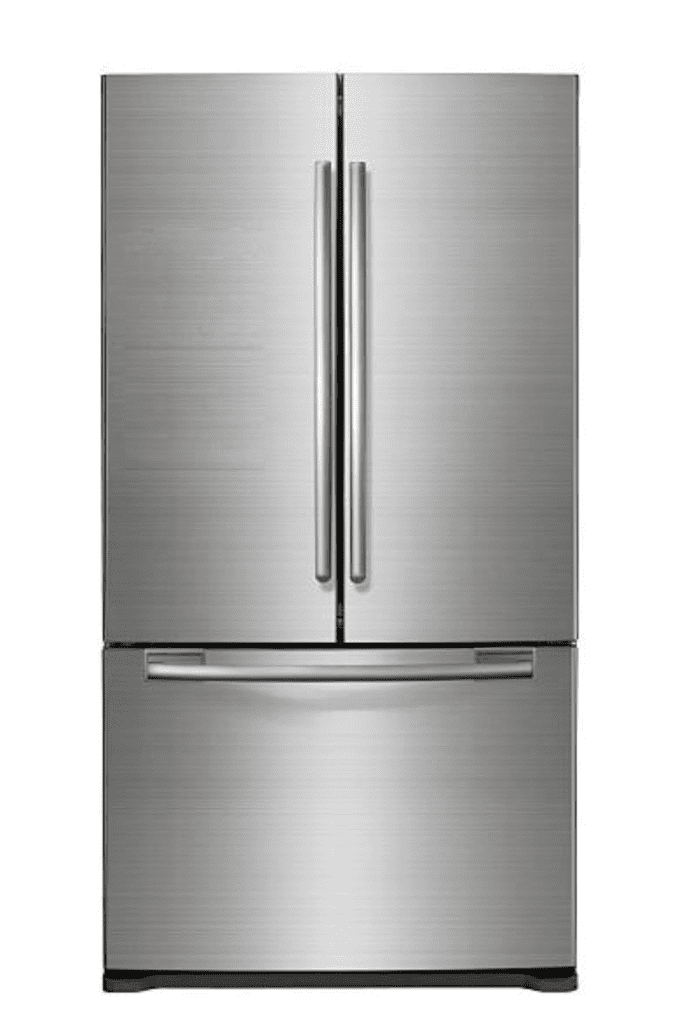
By comparing the energy efficiency ratings of various models, we can uncover which ones consume less electricity while still keeping our food fresh and cold. It’s like finding the perfect balance between performance and sustainability. So, whether you’re in the market for a sleek new fridge or just curious about how your current model stacks up, let’s learn more about the energy usage between different refrigerator models.
Analyzing Energy Consumption Across Various Brands and Types
By comparing the energy efficiency ratings and usage data of different brands and types of appliances, we can gain valuable insights into which ones are the real energy-saving superheroes. Whether it’s a sleek French door fridge or a compact top-freezer model, each appliance has its own energy story to tell.
Analyzing Energy Consumption Across Various Brands and Types of Refrigerators
- Research Energy Efficiency Ratings: Start by researching the energy efficiency ratings of different refrigerator brands and types. Look for labels such as Energy Star, which indicate higher efficiency models.
- Compare Energy Usage Data: Gather energy usage data for different brands and types of refrigerators. This information may be available from manufacturers, retailers, or independent testing organizations.
- Consider Size and Configuration: Take into account the size and configuration of each refrigerator type, such as top-freezer, bottom-freezer, side-by-side, or French door. Larger models may consume more energy, but certain configurations may be more efficient than others.
- Evaluate Features and Technology: Consider additional features and technology offered by each brand and type of refrigerator. While some features may enhance convenience, others may contribute to higher energy consumption.
- Read Reviews and Customer Feedback: Explore reviews and customer feedback to learn about real-world experiences with different refrigerator brands and types. Look for insights into energy efficiency, reliability, and overall performance.
- Calculate Lifetime Energy Costs: Estimate the lifetime energy costs of each refrigerator by multiplying its annual energy consumption by the expected lifespan of the appliance. This can help you compare the long-term cost-effectiveness of different models.
By following these steps, you can conduct a thorough analysis of energy consumption across various brands and types of refrigerators, helping you make an informed decision when choosing the most energy-efficient option for your needs.
Energy Star Ratings and Standards for Refrigerators
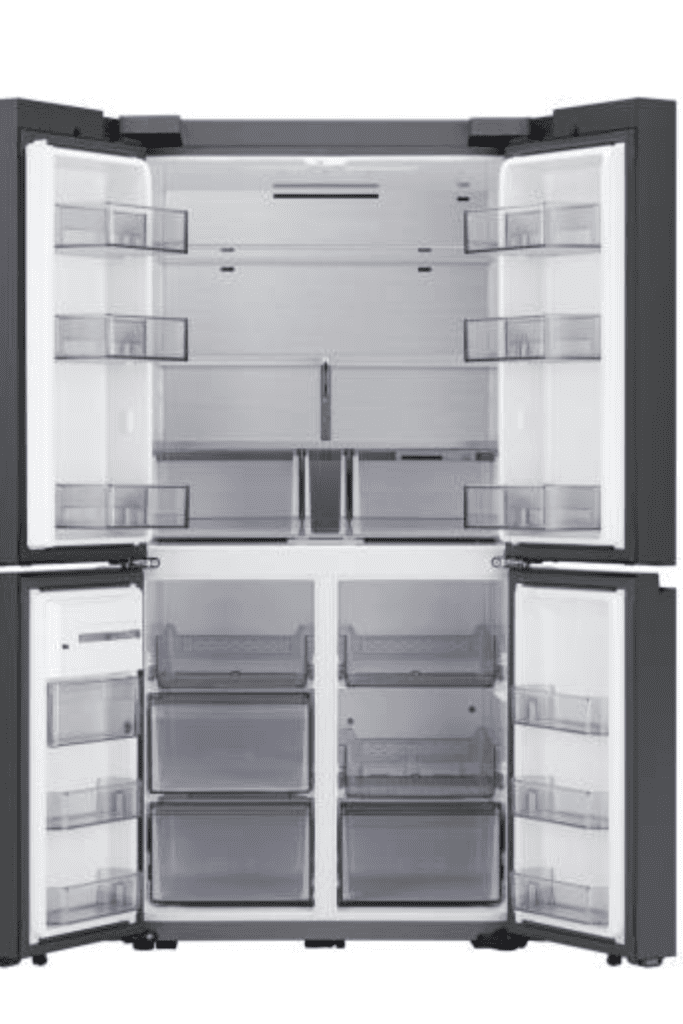
Energy Star sets the bar high, ensuring that the fridges we choose are not only efficient, but also environmentally friendly. Think of it as a seal of approval for sustainability! So, whether you’re in the market for a new fridge or simply curious about how your current one stacks up, it is a good idea to learn all we can about Energy Star.
Overview of the Energy Star Program for Refrigerators
The Energy Star program for refrigerators is a voluntary initiative led by the U.S. Environmental Protection Agency (EPA) and the U.S. Department of Energy (DOE) aimed at promoting energy efficiency in appliances. Refrigerators that earn the Energy Star label meet or exceed strict energy efficiency guidelines set by the EPA. These guidelines are periodically updated to reflect advancements in technology and efficiency standards.
Energy Star refrigerators are designed to consume less energy while still providing reliable cooling performance. They typically incorporate features such as improved insulation, high-efficiency compressors, and advanced temperature controls to minimize energy consumption. By choosing an Energy Star-certified refrigerator, we can reduce their energy bills, lower their carbon footprint, and contribute to a more sustainable future.
Additionally, many utility companies offer rebates or incentives for purchasing Energy Star appliances, further encouraging their adoption. Overall, the Energy Star program for refrigerators provides consumers with a reliable way to identify and choose energy-efficient appliances that meet their needs while also benefiting the environment.
Benefits of Choosing Energy Star Certified Refrigerators
Energy Star refrigerators offer a range of benefits that make them a top choice for eco-conscious consumers.
- First and foremost, these refrigerators are designed to be highly energy efficient, meaning they consume less electricity than standard models. This not only reduces your utility bills, but also helps lower greenhouse gas emissions and lessen your environmental impact.
- Additionally, Energy Star refrigerators often come equipped with advanced features like improved insulation, energy-efficient compressors, and smart temperature controls, all of which help keep your food fresher for longer while consuming less energy.
- Also, choosing an Energy Star refrigerator may qualify you for rebates or incentives from utility companies, further increasing your savings.
Overall, Energy Star refrigerators offer a win-win solution: they save you money, reduce your carbon footprint, and ensure your food stays fresh and delicious.
If you are interested in exploring propane refrigerators for an off-grid approach to cooling your food, then I invite you to check out my detailed post about propane fridges!
The Best Propane Refrigerators for Off Grid Living!
Conclusion
In conclusion, navigating the world of refrigerator energy consumption has been an enlightening journey. From understanding the wattage and energy efficiency of our fridges to exploring the benefits of Energy Star ratings, we’ve equipped ourselves with valuable knowledge to make informed decisions for a more energy-efficient home.
By optimizing fridge placement, analyzing energy consumption across various brands, and embracing Energy Star-certified appliances, we’re not just reducing our utility bills – we’re also taking meaningful steps toward a greener, more sustainable future.
So, let’s continue on this energy-saving adventure together, one watt at a time. Here’s to a cooler, brighter, and more energy-efficient tomorrow!
Understanding how much power your appliances use is crucial for off-grid living—learn more by reading How to Live on Raw Land.
Resources: Here are some helpful resources for further information.
- How Many Watts Do You Need to Run a Refrigerator? – By EcoFlow Blog
- How Many Watts Does a Refridgerator Use? – By Jackery
- How Much Electricity Does a Refrigerator Use? – By Solar Technologies

Frequently Asked Questions
1. How can I determine the wattage of my refrigerator?
Well, determining the wattage of your refrigerator is pretty straightforward! To find this information, you can usually locate a sticker on the back or side of the appliance that lists important details like model number, serial number, and wattage. If you’re unable to find the sticker or it’s worn off, you can also check the owner’s manual or visit the manufacturer’s website for specifications. Keep in mind that different models and sizes of refrigerators will have varying wattages, so it’s important to know your specific appliance’s information when planning for energy usage or calculating electrical needs. Overall, finding out the wattage of your refrigerator is simple with a bit of sleuthing and attention to detail.
2. Are newer refrigerator models more energy-efficient than older ones?
So, here’s the deal with newer refrigerator models versus old ones when it comes to energy efficiency. Basically, yeah, newer models are definitely more energy-efficient than older ones. The technology has come a long way over the years, resulting in refrigerators that use way less electricity to keep your food cold. The Energy Star program recommends upgrading to a new model if your fridge is more than 10 years old to save on energy costs. Newer fridges have better insulation, LED lighting, and advanced compressor technology that all contribute to their improved energy efficiency. Plus, who doesn’t love saving some cash on their utility bills while also reducing their environmental impact? Upgrading to a newer model is a win-win situation for both your wallet and the planet!
3. Can changing the temperature settings of my fridge affect its energy consumption?
Yes, changing the temperature settings of your fridge can significantly impact its energy consumption. Refrigerators are among the top energy-consuming appliances in the average household, and adjusting the temperature can either reduce or increase this consumption. Setting your fridge too low can cause it to work harder than necessary to maintain a colder temperature, leading to greater energy usage. On the other hand, setting it too high may result in food spoilage and wasted energy as the appliance struggles to keep items adequately chilled. The ideal refrigerator temperature is typically between 37-40 degrees Fahrenheit for the fresh food compartment and 0 degrees Fahrenheit for the freezer. By keeping your fridge at these recommended levels, you can help optimize energy efficiency and reduce your electricity bill while ensuring that your food stays safe and fresh.
4. What are some common maintenance practices to improve the energy efficiency of my refrigerator?
One common maintenance practice to improve the energy efficiency of your refrigerator is to regularly clean the condenser coils. These coils are responsible for removing heat from inside the fridge, helping it run more efficiently. Dust and debris can build up on these coils over time, causing them to work harder and use more energy. Another helpful tip is to check the door seals for any signs of wear or damage. If the seals are not properly sealed, cool air can escape, forcing the fridge to work harder to maintain temperature. Additionally, keeping your fridge well-stocked helps it maintain a consistent temperature more easily. Lastly, setting the temperature of your fridge and freezer compartments to recommended levels (around 37°F for the fridge and 0°F for the freezer) can also help improve energy efficiency.
Summary
I hope I have inspired you to live sustainably with these tips and products.
If you were encouraged by this post, I invite you to check out my FREE Printables Page for fun free printables, planners, and charts.
ENTER MY FREE Printables Page HERE
Here are some more of my gardening inspiration posts to check out!
How to Feed Your Family During the Government Shutdown
12 Best Tips for Creating an Eco-Friendly Household
Survival Lessons from the Great Depression
The Best 15 Homesteading Blogs to Follow for Inspiration
How to Criminal-Proof Your Home with These 5 Steps
How to Create Your Cottagecore Aesthetic Dream Home
Ideas for Rustic Living Room Vibes You’ll Love All Year Round!
How to Prep Your Home for Chilly Fall Nights
Bring Back the Magic of Fireflies and Lightning Bugs with Solar Power!
The Ultimate Portable Power Bank for Homesteaders and Preppers!
A Bug Out Bag That’s Actually Ready — When You Need It Most!
Magical Ways to Use Fairy Lights in Your Off-Grid Home
How to Live a Cozy Off-Grid Life
The Best Off-Grid Kitchen Tools for Indoors (No Power Needed!)
DIY Solar Made Simple: How I Powered My Off-Grid Life with Practical Preppers!
Sleeper Cells in America: What You Need to Know Now!
How People Are Surviving in Broken Cities with Broken Systems
When the World Hurts, We Prepare with Purpose
How to Live On Raw Land: Everything You Need to Know!
How to Do Off-Grid Laundry with Eco-Friendly Laundry Detergent!
Hollywood on Fire! What Secrets Are In the Ashes?
FEMA Concentration Camps? Are Echos of the Past Returning?
How Likely Is a Russian EMP? One Pulse Could Black Us Out!
What Dark Secrets Lie in The Bird Flu Symptoms?
The Blackout Sun: Who Is Blacking Out Our Sunlight?
More Posts!
How to Bug-In During a Deep Freeze!
‘FOGVID-24?’ What’s in the Mysterious Fog That’s Making Everyone Sick?
From Snow to Sow: Plan Your Spring Garden Now!
11 Fun Ways to Brighten Your Spring Garden with Personality
Top 10 Spring Garden Crops to Harvest in 30 Days and Eat Now!
The Best Survival Crops for Caloric Survival
More Posts!
My Victory Garden: What I Learned from 5+ Years
Why Every Family Should Have a Victory Garden in Their Backyard Now!
The Best Perennials for a Long-Term Survival Garden
The Best Essential Oils for Plants That Repel Garden Bugs
How to Grow Green Garden Peas: Perfect Plump Peas!
Hugelkultur: Does This Epic Pioneering Method Actually Work?
9 Ways to Celebrate Earthing Day in Your Garden!
Gardening Indoors: Secrets of Growing Your Food Inside!
How to DIY a Milk Jug Drip Irrigation System!
Why Cedar Mulch Is The Perfect Natural Weed Barrier
Gardening Projects
Onions: How to Grow Onions for Storage
Peas: How to Grow Garden Peas for a Bumper Crop
Carrots: How to Grow Carrots for a Bountiful Harvest
Prep Your Garden for Spring Planting with These Expert Tips!
How to Grow a Prepper Garden to Survive and Thrive
The Best Garden Tools You Need for a Productive Season
Fastest Growing Vegetables for Your Survival Garden
How to Grow Marigolds As Pest Control In Your Vegetable Garden
Must-Have Tools for a Successful Balcony Vegetable Garden
How to Effectively Combat Powdery Mildew in Your Garden
The Best Tips for Organic Gardening
How to Release Ladybugs In Your Garden for Organic Pest Control
More Posts!!
The Best Garden Snail Control Strategies
The Best Spring Vegetables to Grow in Your Garden
Seed Starter Mix: How To Make Your Organic Seed Starter Mix At Home
How to Grow a Productive Canning Garden
How to Plant and Grow a Salsa Garden
Easiest Heirloom Vegetable Seeds to Grow Now
How to Use the Hand Twist Claw Tiller: Tackling Tough Soil
More Fun Gardening Posts to Check Out!
Planning Your Garden: How to Plan a Vegetable Garden: Expert Green Thumb Tips!
Winterizing the Garden: How to Winterize Your Vegetable Garden: Step-by-Step Checklist
Mulching the Garden: How to Make Leaf Litter Mulch
Grow a Pumpkin Patch: How to Grow a Pumpkin Patch in Your Backyard
How to Grow a Fall Garden: 9 Best Fall Crops
Clever Ways to Incorporate Indoor Composting into Your Home
How to Start Composting for the Garden: A Step-by-Step Guide
The Ultimate Guide to Composting in Your Suburban Backyard
Why I Built A Survival Garden in My Backyard
16 Best Medicinal Herbs to Grow in Your Garden Now
Blessings,
The Off Grid Barefoot Girl

